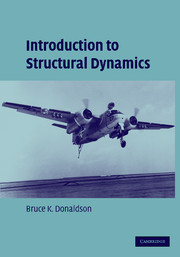Book contents
- Frontmatter
- Contents
- Preface for the Student
- Preface for the Instructor
- Acknowledgments
- List of Symbols
- 1 The Lagrange Equations of Motion
- 2 Mechanical Vibrations: Practice Using the Lagrange Equations
- 3 Review of the Basics of the Finite Element Method for Simple Elements
- 4 FEM Equations of Motion for Elastic Systems
- 5 Damped Structural Systems
- 6 Natural Frequencies and Mode Shapes
- 7 The Modal Transformation
- 8 Continuous Dynamic Models
- 9 Numerical Integration of the Equations of Motion
- Appendix I Answers to Exercises
- Appendix II Fourier Transform Pairs
- Index
Preface for the Instructor
Published online by Cambridge University Press: 30 November 2009
- Frontmatter
- Contents
- Preface for the Student
- Preface for the Instructor
- Acknowledgments
- List of Symbols
- 1 The Lagrange Equations of Motion
- 2 Mechanical Vibrations: Practice Using the Lagrange Equations
- 3 Review of the Basics of the Finite Element Method for Simple Elements
- 4 FEM Equations of Motion for Elastic Systems
- 5 Damped Structural Systems
- 6 Natural Frequencies and Mode Shapes
- 7 The Modal Transformation
- 8 Continuous Dynamic Models
- 9 Numerical Integration of the Equations of Motion
- Appendix I Answers to Exercises
- Appendix II Fourier Transform Pairs
- Index
Summary
This textbook is designed to be the basis for a one-semester course in structural dynamics at the graduate level, with some extra material for later self-study. Using this text for senior undergraduates is possible also if those students have had more than one semester of exposure to rigid body dynamics and are well versed in the basics of the linear, stiffness finite element method. This textbook is suitable for structural dynamics courses in aerospace engineering and mechanical engineering. It also can be used in civil engineering at the graduate level when the course focus is on analysis rather than earthquake design. The first two chapters on dynamics should be particularly helpful to civil engineers.
This textbook is a departure from the usual presentation of this material in two important ways. First, from the very beginning, descriptions of system dynamics are based on the simpler-to-use Lagrange equations. To this end, the Lagrange equations are derived from Newton's laws in the first chapter. Second, no organizational distinctions are made between multidegree of freedom systems and single degree of freedom systems. Instead, the textbook is organized on the basis of first writing structural system equations of motion and then solving those equations mostly by means of a modal transformation. Beam and spring stiffness finite elements are used extensively to describe the structural system's linearly elastic forces. If the students are not already confident assemblers of element stiffness matrices, Chapter 3 provides a brief explanation of that material.
- Type
- Chapter
- Information
- Introduction to Structural Dynamics , pp. xv - xviPublisher: Cambridge University PressPrint publication year: 2006

